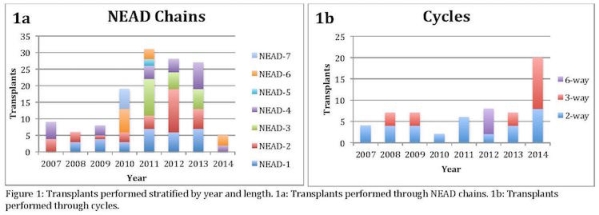Matching Strategies in Kidney Paired Donation: A 7-Year Analysis of a Multi-Institutional Registry
D. Fumo,1,2 L. Reece,2 S. Stepkowski,1 V. Kapoor,1 S. Rees,2 J. Kopke,2 M. Rees.1,2
1University of Toledo Medical Center, Toledo, OH
2Alliance for Paired Donation, Maumee, OH.
Meeting: 2015 American Transplant Congress
Abstract number: 102
Keywords: Donors, Kidney transplantation, Methodology, Outcome, unrelated
Session Information
Session Name: Concurrent Session: Kidney: Living Donor Issues I
Session Type: Concurrent Session
Date: Sunday, May 3, 2015
Session Time: 4:00pm-5:30pm
 Presentation Time: 5:00pm-5:12pm
Presentation Time: 5:00pm-5:12pm
Location: Terrace IV
Failure to convert computer-identified possible Kidney Paired Donation (KPD) exchanges into transplants has prevented KPD from reaching its full potential. The purpose of this study is to review and analyze the efficacy of two different methods of generating KPD transplants.
The Alliance for Paired Donation (APD) utilizes an optimization algorithm that selects either simultaneous closed loop exchanges (Cycles) or Non-simultaneous Extended Altruistic Donor (NEAD) chains. NEAD chains are initiated by a non-directed donor (NDD) and end with an overhanging bridge donor, who is entered back into the pool. This bridge donor can then initiate another NEAD chain at a later date. Computer-generated potential cycles and NEAD chains are presented to transplant centers for review, at which point they become a formal offer. The progress in moving from offer to completed transplants was tracked and recorded in order to calculate the success rate (SR).
Between January 2007 and August 2014 the APD performed 225 transplants: 194 within the APD as well as 31 in collaboration with other KPD programs. Of the 194 APD transplants, 61 (31.4%) were performed through cycles (Figure 1a). In contrast, 133 out of 194 transplants (68.6%) were performed through chains (Figure 1b), suggesting that chains were two times more successful than cycles. The APD made 447 offers to transplant centers, of which 173 (38.7%) were cycles and 274 (61.3%) were chains. The SR of cycles was 14.5%, compared to 26.6% for chains. The overall SR was 21.9%.

The APD, in conjunction with other registries, has successfully performed 225 KPD transplants, the majority of which were NEAD chains. Though chains were not actively sought over cycles, the results demonstrate that chains were 1) more likely to be found by the optimization algorithm and 2) more likely to progress to completed transplants than cycles. The concept of a bridge-donor introduces significant flexibility in generating transplants. We propose that NEAD chains are the most effective tool to increase the efficiency in KPD programs.
To cite this abstract in AMA style:
Fumo D, Reece L, Stepkowski S, Kapoor V, Rees S, Kopke J, Rees M. Matching Strategies in Kidney Paired Donation: A 7-Year Analysis of a Multi-Institutional Registry [abstract]. Am J Transplant. 2015; 15 (suppl 3). https://atcmeetingabstracts.com/abstract/matching-strategies-in-kidney-paired-donation-a-7-year-analysis-of-a-multi-institutional-registry/. Accessed December 25, 2025.« Back to 2015 American Transplant Congress
